Corydoras are a great addition to any South American-themed aquarium containing generally peaceful small and medium-sized fish. Larger varieties can even hold their own against bigger and more boisterous tankmates. However, it’s a smaller variety that is, perhaps, our absolute favourite at Your Aquarium.
Aside from the true pygmy corydoras species—Corydoras habrosus, hastatus, and pygmaeus—the panda cory, Corydoras panda, is one of the smallest corys regularly offered for sale. Named for its panda-like markings, panda corys are typically a pinkish-tan colour with black panda stripes and spots. Many also possess a metallic sheen.
Peaceful, attractive, and usually topping out at around 4cm, they’re a fun fish, too. Incredibly playful when kept in larger numbers, a group of happy panda corys will regularly spawn as well, laying clutches of eggs around the tank. With sufficient hiding places, it’s not uncommon for eggs to hatch and young to survive, so there’s frequently the potential to end up with more than you bought initially!
Panda cory species profile
| Common name | Panda cory |
| Scientific name | Corydoras panda |
| Classification | Callichthyidae |
| Subfamily | Corydoradinae |
| Wild distribution | Peru, South America |
| Maximum size | Males 3.5cm, females 4.5-5cm |
| Aquarium type | Tropical freshwater |
| Group size | Best in groups of six or more, ideally 10+ |
| Swimming level | Bottom, lowermost-middle |
| Tankmates | Peaceful small and medium-sized species |
| Diet | Unfussy, omnivorous |
| Optimum temperature | 22°C to 24°C |
| pH range | pH 6 to pH 7.5 |
| Water hardness | Up to a general hardness (GH) of 12 |
| Cost | From around £3.50 per fish |
Panda cory pictures




Panda cory temperament
Panda corydoras are entirely peaceful. There can be a little rough and tumble between males and females, but neither should come to any harm. Friendly and relaxed with other similarly sized cory species, too.
Panda cory tankmates
Tankmate-wise, panda corys are best housed with other peaceful, small and medium-sized fish. Those from South America will always be preferable. Better still, other fish from Peru are ideal – particularly those with similar temperature requirements.
Tetras, smaller apistogramas, and other corys are all excellent potential tankmates. However, remaining mindful of panda corys’ lower temperature preferences, so-called German rams and other warmer water fish must be avoided. In terms of rams, Bolivian rams are a good alternative.
Hatchetfish, pencilfish, and other peaceful catfish and dwarf cichlids are also great options. However, avoid any potentially territorial bottom-dwelling species to alleviate the risk of aggression toward your panda corys. Safe with all but the very smallest of tankmates, including the likes of green neon tetras (Paracheirodon simulans), fry may be eaten but are usually ignored by the majority of Corydoras panda.
Panda cory temperature
Like lots of corydoras species, pandas prefer slightly cooler temperatures. Around 22-24°C is best, and temperatures above 25°C should always be avoided. With that, they’re not candidates for discus tanks where varieties like Sterba’s cory, Corydoras sterbae, are more appropriate. Other than that, they’re largely undemanding as long as the temperature and other water parameters don’t fluctuate.
Panda cory feeding
As far as diet, at Your Aquarium, we feed our own panda corys on a mix of high-quality sinking pellets and various frozen foods. Defrosted frozen bloodworm and glassworm are particularly relished. They’ll also sift through the substrate for uneaten food left by other fish, including flake, daphnia, cyclops, and more. Some panda corys also enjoy algae wafers.
Panda cory habitat
In their native habitat in the upper Amazon river in Peru, aquatic plants aren’t a common feature. Instead, wild panda corys tend to live among rocks and the twisted roots of terrestrial plants and trees. In the aquarium, they do, however, take kindly to plants and will often lay their eggs on the undersides of the leaves of Amazon swords and suchlike. A reasonable degree of water flow is also appreciated.
Panda cory substrate
Happiest with a soft sand substrate. Avoid anything with sharp edges, including courser types of sand, as these can damage panda corys’ delicate mouths as they sift for food. If using gravel, a small, pea-type variety is best, but soft sand is always preferable.
Panda cory availability
Panda corys were first introduced to the aquarium hobby in the late 1970s. Now more popular than ever, there’s good news when it comes to availability as a result. That’s because almost all of the panda corys available in the aquarium hobby today are captive-bred. Panda corys are now almost never collected from the wild.
Panda cory price
Surprisingly pricey given their widespread availability and ease of breeding, expect to pay anywhere from £3.50-£7.50 for small and medium-sized panda corys bought from local fish shops. Larger examples will set you back more, with breeding trios regularly selling for upwards of £30 – equivalent to more than £10 per fish.
A more affordable option is invariably to source fish from fellow hobbyists and breeders. Local aquarium clubs and auctions are often a fantastic source of home-bred fish, including panda corys and other, more unusual corydoras species.
Other observations
Like other corys, pandas possess the ability to breathe air from the water’s surface as well as underwater through their gills. To do so, they dash up for a gulp before diving straight back to the substrate level. So, don’t be surprised by this behaviour. It’s normal for all corys, although pandas don’t do it as often as some species, like the tiny Corydoras pygmaeus.
Furthermore, they also bear the same sharp pectoral fins as other corydoras species. As such, some care is required when handling, namely to prevent them from getting caught in nets. If this happens, gently de-tangle them with your thumb and forefinger, taking care not to prick yourself in the process.
(Panda cory pictures courtesy of Dornenwolf.)






